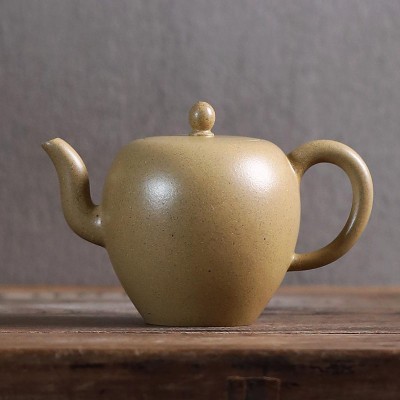







"Meirenjian" yixing teapot resembles an ancient woman, dignified and lovely, with a hint of palace elegance and grace, yet without losing the charm of a young lady. The shape is full and elegant, mainly reflecting the roundness of the pot body. The pot cover and the pot body seem to be integrated without any gaps. When touched by hand, one can feel its warmth.
 Delivery
Delivery
Free shipping within 1 to 3 days. ETA:5-7 days
 Returns
Returns
Within 28 days after delivery date.
 Security
Security
SSL | GDRP used to ensure information security.
Guarantee safe & secure checkout
Data sheet
The appearance design of this yixing teapot is very distinctive,sames like a east pretty lady ,it's very easy to use, and the tea it brews is very mellow. Highly recommend!
"Meirenjian" yixing teapot resembles an ancient woman, dignified and lovely, with a hint of palace elegance and grace, yet without losing the charm of a young lady. The shape is full and elegant, mainly reflecting the roundness of the pot body. The pot cover and the pot body seem to be integrated without any gaps. When touched by hand, one can feel its warmth.
"Meirenjian" yixing teapot resembles an ancient woman, dignified and lovely, with a hint of palace elegance and grace, yet without losing the charm of a young lady. The shape is full and elegant, mainly reflecting the roundness of the pot body. The pot cover and the pot body seem to be integrated without any gaps. When touched by hand, one can feel its warmth.
"Rongtian" yixing teapot takes its inspiration from the "big-bellied" Arhat in Buddhism, named after the saying "a big belly can hold the world's affairs". It is difficult to fully capture the charm of this teapot, as it requires the maker to truly understand its essence. A slightly shorter neck is added to the full-bodied teapot, while the lid is raised to a half-spherical shape, giving it a simple and childlike charm. The teapot has excellent pouring performance and is comfortable to use. Visually, it exudes a dignified and generous aura while embodying depth within simplicity.
"Julun" yixing teapot- this "Julun" zisha teapot is designed for practicality, with a spout that ensures smooth water flow and a handle that is easy to grip. The lid is also uniquely designed for easy removal. Despite its distinctive and eye-catching appearance, the "Julun" teapot is a functional and practical utensil that is highly valued by tea enthusiasts for its ability to brew tea effectively and efficiently. Its unique shape allows tea leaves to fully expand, releasing more aroma and flavor. The name "JuLun" comes from its shape, which resembles an upside-down cartwheel. This teapot is not only aesthetically pleasing but also highly functional, making it a popular choice among tea lovers and collectors.
The "Longdan" Yixing teapot, also known as the Dragon Ball Teapot, has an oval shape with a flat bottom and a smaller top, resembling an egg. It is crafted using traditional handmade techniques, with intricate carvings and fine texture that result in a deep and rich color. This teapot has excellent heat preservation and enhances the aftertaste of tea, making it suitable for brewing various types of tea. It is both elegant and practical, making it a highly sought-after Zisha teapot.
"Duozhi" yixing teapot is a unique and distinctive shape in the world of Yixing zisha teapots. Its shape resembles a pile of spheres and hemispheres stacked together, giving it a unique and eye-catching appearance. The name "Duo Zhi" comes from the Chinese word for "stacking and linking." Due to its unique appearance, this type of teapot is commonly referred to as the "Duozhi teapot." Interestingly, the name "Duozhi" in Chinese also carries a positive connotation, meaning "many children, much happiness." This adds to the charm and appeal of this teapot, making it a popular choice for collectors and tea enthusiasts alike.
"Jizhi" yixing teapot has a straight cylindrical body with a shoulder, short neck, and straight spout. The handle is free-flowing and ear-shaped, while the lid fits tightly. The bottom of the pot is neatly crafted with exquisite workmanship. The overall design of the pot displays a strong contrast between thick and thin lines, as well as between straight and curved lines, giving it a deep, simple, and powerful temperament. At the same time, it also exudes a sense of elegance and grace. It seems that the "Jizhi" teapot conveys a spirit of honesty and justice, daring to advise others.
A flattened persimmon-shaped teapot is called a "Short Pan," a slightly taller and flattened spherical-shaped teapot is called a "Medium Pan," and a teapot with a taller and pear-shaped body is called a "Tall Pan." When their daughters got married, they would give a Pan teapot as part of their dowry, hoping that their daughters would be able to live a prosperous life like "Pan Shicheng" who the inventor of the "pan" teapot. teapots that are passed down as part of the dowry are not necessarily used for brewing tea, but can also be placed on dressing tables to hold hair oil. After the female owner passes away, they are often used as burial objects to show gratitude to her family for raising her.
The design of the "Xubian" zisha teapot is a combination of the elements of the "Xubian" and the "Gongdeng". "Xubian" refers to the flat shape of the body of the pot, while "Gongdeng" refers to the shape of the lid of the pot, which is like a palace lamp. This design not only retains the characteristics of traditional purple clay pots, but also adds some new elements, making the "Biandeng" more ornamental and collectible.
"De" means morality,"zhong" means "bell",The bell-shaped lid and body of this zisha teapot symbolize a person with noble character, frugality, and simplicity. Owning this teapot is seen as a sign of being a true gentleman, as it represents the values of humility and refinement.
"Rongtian" yixing teapot takes its inspiration from the "big-bellied" Arhat in Buddhism, named after the saying "a big belly can hold the world's affairs". It is difficult to fully capture the charm of this teapot, as it requires the maker to truly understand its essence. A slightly shorter neck is added to the full-bodied teapot, while the lid is raised to a half-spherical shape, giving it a simple and childlike charm. The teapot has excellent pouring performance and is comfortable to use. Visually, it exudes a dignified and generous aura while embodying depth within simplicity.
The design of the Palace Lamp "Gongdeng" in the Yongzheng period of the Qing Dynasty. Its prototype was a lantern, designed by an old man from Tuntou Village. Later, the Tuntou Lantern was presented as a tribute to a county-level official who took it to the palace. The Tuntou Lantern was named "Gongdeng" and became an exclusive item for the imperial palace. Later, people replaced the character "Gong" with "Palace," and it became the "Palace Lamp" we know today. The Palace Lamp teapot is designed based on this lantern, often appearing in a square shape with a fresh, natural, and elegant style that is in line with the aesthetic views of ancient people and easily accepted by modern people.
A flattened persimmon-shaped teapot is called a "Short Pan," a slightly taller and flattened spherical-shaped teapot is called a "Medium Pan," and a teapot with a taller and pear-shaped body is called a "Tall Pan." When their daughters got married, they would give a Pan teapot as part of their dowry, hoping that their daughters would be able to live a prosperous life like "Pan Shicheng" who the inventor of the "pan" teapot. teapots that are passed down as part of the dowry are not necessarily used for brewing tea, but can also be placed on dressing tables to hold hair oil. After the female owner passes away, they are often used as burial objects to show gratitude to her family for raising her.
"Duoqiu" yixing teapot is a classic example of a geometric-style traditional round teapot and one of the finest representatives of purple clay teapots. Its basic form consists of a pot knob, pot cover, and pot body, composed of small, medium, and large spheres arranged in sequence. The pot belly is a large sphere, and the pot cover is a small sphere, giving the appearance of a small ball placed on top of a large ball, hence the name "duoqiu" teapot. This unique design creates a visually striking and aesthetically pleasing teapot that is highly prized by collectors and tea enthusiasts alike.
A flattened persimmon-shaped teapot is called a "Short Pan," a slightly taller and flattened spherical-shaped teapot is called a "Medium Pan," and a teapot with a taller and pear-shaped body is called a "Tall Pan." When their daughters got married, they would give a Pan teapot as part of their dowry, hoping that their daughters would be able to live a prosperous life like "Pan Shicheng" who the inventor of the "pan" teapot. teapots that are passed down as part of the dowry are not necessarily used for brewing tea, but can also be placed on dressing tables to hold hair oil. After the female owner passes away, they are often used as burial objects to show gratitude to her family for raising her.
The Xishi yixing teapot is the quintessential model and the most popular style of Yixing clay teapot. It boasts a round and plump body, a cut lid, a short spout, and an inverted handle. The pot's body resembles the full breast of a young woman, while the knob on the lid is shaped like a nipple. The bottom of the pot curves inward naturally, and the handle is fashioned like an upside-down ear, reminiscent of the hairstyle of ancient Chinese women. When pouring tea, the handle resembles the slender waist of a beautiful woman. The Xishi teapot is renowned for its unique ability to brew tea, allowing the tea leaves to fully expand and release a more intense aroma and flavor.
The design of the Palace Lamp "Gongdeng" in the Yongzheng period of the Qing Dynasty. Its prototype was a lantern, designed by an old man from Tuntou Village. Later, the Tuntou Lantern was presented as a tribute to a county-level official who took it to the palace. The Tuntou Lantern was named "Gongdeng" and became an exclusive item for the imperial palace. Later, people replaced the character "Gong" with "Palace," and it became the "Palace Lamp" we know today. The Palace Lamp teapot is designed based on this lantern, often appearing in a square shape with a fresh, natural, and elegant style that is in line with the aesthetic views of ancient people and easily accepted by modern people.
"wendan" in Chinese refers to softness, appearance, and demeanor, while "dan" refers to the female roles in traditional Chinese opera. To literati, the charm and style of the "wendan" teapot are comparable to the beauty of a woman's shoulder, soft and boneless, like the alluring curves of "Xishi", exuding a natural grace and charm. The "wen" in "wendan" represents the soft, delicate appearance of the teapot, while the "dan" represents the feminine qualities that the teapot embodies. The "wendan" teapot is highly valued for its unique and elegant shape, which exudes a natural beauty and grace that is reminiscent of the beauty of a woman.
NOTICE : Cookies ensure the smooth running of our services and improve user experience,Using these, you accept the use of cookies. Learn More.